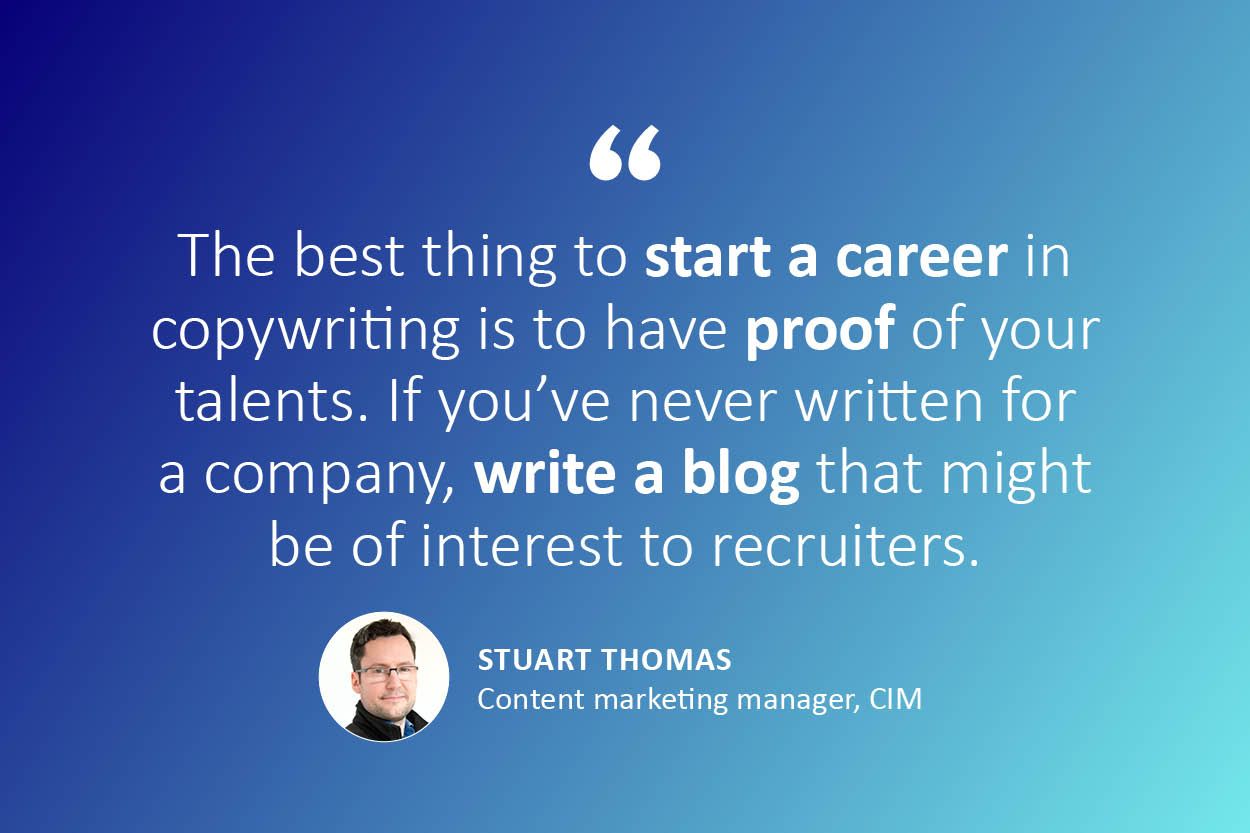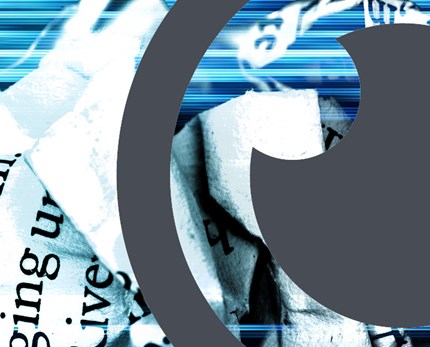Copywriting basics – your questions answered

- 14 July 2023
Following on from our Copywriting – the basics of a marketing cornerstone Marketing Club webinar, we’ve gathered together some of the questions that weren’t answered, and expanded on those that were. With the presenter Stuart Thomas, CIM content marketing manager, we dive deeper into this marketing fundamental.
As is always the way with Q&A sessions, there’s never enough time to answer them all. Even with a sea of virtual hands going up, only a lucky few will get picked to be heard and replied to. Over 40 questions were asked, some with similar themes, and there was only time for four before the session was over.
The first question was on the most popular theme – AI.
To give your copywriting a jumpstart or mature your writing abilities, sign up for our on-demand Copywriting – the complete guide training course. If you'd like to learn more about the CIM Marketing Club, visit our CIM Marketing Club page and sign up.
How does AI apply to copy and content writing?
!["The best uses I've seen [of AI in copywriting] so far are when the program is used to generate (bolded text) ideas (not bolded), rather than (bolded text) whole content (not bolded). But even this isn't free from unoriginal ideas - quote from Stuart Thomas, content marketing manager at CIM](/media/11634/marketing-club-st-copywriting-webinar-quote-600x400_1.jpg)
The big question on every writer’s keyboard.
The rise of ChatGPT and Open AI has not gone unnoticed by marketers. If anything, they’ve contributed to its meteoric rise with lots of content around ChatGPT, some of it generated by ChatGPT itself.
The use of AI in content production should be approached with caution. So far, there have been telltale signs when ChatGPT and other programmes have been used to produce long-form content, not least because it repeats itself often. It could also plagiarise, and you’d never know without scouring the internet yourself.
The best uses I’ve seen so far are when the program is used to generate ideas, rather than whole content. But even this isn’t free from – not exactly plagiarism – unoriginal ideas. ‘Suggest ten so-far-unused headlines on copywriting’ produces:
- "The Art of Persuasion: How to Write Copy That Converts"
- Exists as a YouTube video and article on Jounce AI
- "The Secret to Effective Copywriting: Understanding Your Audience"
- Exists as an article on LinkedIn , replacing ‘secret’ with ‘key’
- "From Headline to Call-to-Action: The Elements of a Winning Sales Page"
- Jounce AI again, everything after the colon
- "Mastering the Power of Words: Tips for Writing Compelling Copy"
- Unique in this order
- "Copywriting 101: How to Craft Messaging That Resonates"
- 799k results for Copywriting 101. Article from 2015 on the latter
- "The Dos and Don'ts of Copywriting for Digital Marketing"
- "How to Use Storytelling to Captivate Your Audience and Drive Sales"
- Unique in full
- "The Psychology of Persuasion: Understanding the Science of Copywriting"
- Close match from DSLX
- "Creating a Brand Voice: Tips for Consistent Copywriting Across Platforms"
- First half from HubSpot, second half is an opportunity
- "Copywriting for SEO: Techniques for Writing Content That Ranks"
- An article from Ahrefs, replace ‘techniques’ for ‘tips’
As you can see, one prompt is not enough for AI to solve all your content woes. There’s still work to do researching, learning, proofing, editing, but you can freely use AI for a nudge. To get better at prompting, check out our AI for copywriting course, specialising in prompting.
But above all, note ChatGPT’s own disclaimer:
ChatGPT may produce inaccurate information about people, places, or facts.
And when asked, “As an AI language model, I [ChatGPT] don't have access to all of the content published online”.
You’ll still have to read a book or learn from an expert. AI is getting towards being ‘as good as a human’ – but not yet.
What’s the difference between a hyphen and a dash?
About 5 pixels. Hyphen (-), dash (–). Only the mightiest of pedants will point out that your dash looks like a hyphen – or vice-versa – when used the wrong way round. The only place the terminology might matter is in coding your content, where each has a specific Unicode term which can cause issues moving between systems. En dash (–) is U+2013, while hyphen (-) is U+002D.
Unless you’re a linguist, or coding all of your pages in HTML and Unicode, the two can be considered ‘the same’. Just remember a hyphen doesn’t have spaces around it – while a dash does
And the less said about em dash (—, U+2014), the better.
Most word processor programmes will correct to the right one, and WYSIWYG ( What You See Is What You Get) editors can manage either. For the context of the webinar, it’s replacing comma clauses with dashes that you should get comfortable with doing.
How to write an SEO friendly 1000-word blog post in two hours
The easiest way to write a long blog in two hours is to have a very clear idea of what you’re writing about. From beginning to end, idea to publish, a blog should take a few days of planning. Assuming we’re skipping the planning stage and a rough title has been outlined, here’s a 5-step guide to writing a blog post quickly:
1. Identify the target keyword(s) – 5 minutes
With a title outlined (or a few), you can pick out the keyword that’s in all of them. With this keyword, you know what should come up again and again across the post
2. Write a short summary of the article – 15 minutes
Like a synopsis to sell your article, summarise what you’re going to write about. Not only does this form the basis of what follows, but it can get the creative juices flowing.
3. Consider your subheadings – 10 minutes
Sometimes these will pop up as you go, but they can also come from your alternative rough titles. If you’re writing top tips, make each tip a subheading. If any tips need more explanation than the others, make it a sub-subheading.
4. Write, write, write – 1 hour
The only way to write a blog post in two hours is to be writing for as much as possible. Remove distractions like talk radio or Teams, and put fingers to keyboard. Don’t worry about formats.
The Average typing speed is 40 words a minute, so you could theoretically write 2400 words in this time if you never stopped.
5. SEO-ify it – 30 minutes
Once you’ve written it, run through it and separate the paragraphs. Add links, bold important words, and make sure your subheadings are formatted to H2 and below. Check your keyword(s) is used as often as is reasonable.
How to teach yourself SEO
Here’s how I’d frame this – you can only learn so much from the school of life. You can get quite far ‘teaching yourself’ anything, not least when Google is packed full of articles on SEO from companies trying to sell you services on SEO. But then think of all the people who learned ‘fractal burning’ online then electrocuted themselves.
Not learning SEO right won’t kill you, but it’ll lead to some awkward conversations at your next job if all you did was teach yourself.
The fundamentals are straightforward – SEO is doing what Google wants you to do. But what does Google want you to do? The easiest way to find out is to go to Google and search for something, anything, then look at the results you’re being given.
Look at how the pages are laid out, look at how the first subheading often repeats the main title. Check out the url in the address bar – how well does it align with the page content? Use Chrome’s ‘inspect’ tool on the images, see how the alt text either includes a keyword or is informative of the image.
Like all marketing, SEO includes a heavy amount of experimentation. Write blog posts, see how they perform using Google Analytics, make tweaks to them then see if your analytics improve. If they did, hey presto – you’ve done some SEO.
To gain inspiration for blogs, check out answerthepublic to find questions around your keywords, or do some googling. SEMrush has some free options and a keyword tool within, but to get really in-depth you’ll have to pay for a tool.
Then go on a CIM Search Engine Optimisation (SEO) course and skip the experimentation to learn from someone who isn’t trying to sell you something.
How to start a career in copywriting

The best thing to start a career in copywriting is to have proof of your talents. If you’ve never written for a company, write a blog that might be of interest to recruiters, like a regular dive into a hobby of yours. Don’t just write a diary!
Your blog likely won’t make waves on the internet, but if you can prove you understand SEO principles (without necessarily gaining results from them, because it’s hard), you’ll stand out. And show that you’re writing for a specific audience too – people of a certain age interested in your hobby, for example.
Make your CV well-suited to words. While there’s a strict-ish format to follow, you can get creative with your intro, covering letter, and explanations of skills. If you have extracurricular activities that support an interest in words (like, say, avid reader), add it to the interests and skills at the end and be ready to speak about it.
Companies and agencies are looking for slightly changing styles too. Demonstrate, in whatever way you can, that you can write for different audiences and/or platforms. Take those blog posts you’ve written, and push them on your LinkedIn with LinkedIn-appropriate wording.
To give your copywriting a jumpstart or mature your writing abilities, sign up for our on-demand Copywriting – the complete guide training course.

Tags:
- 0 views

 FAQs
FAQs
 Log in
Log in
 MyCIM
MyCIM






